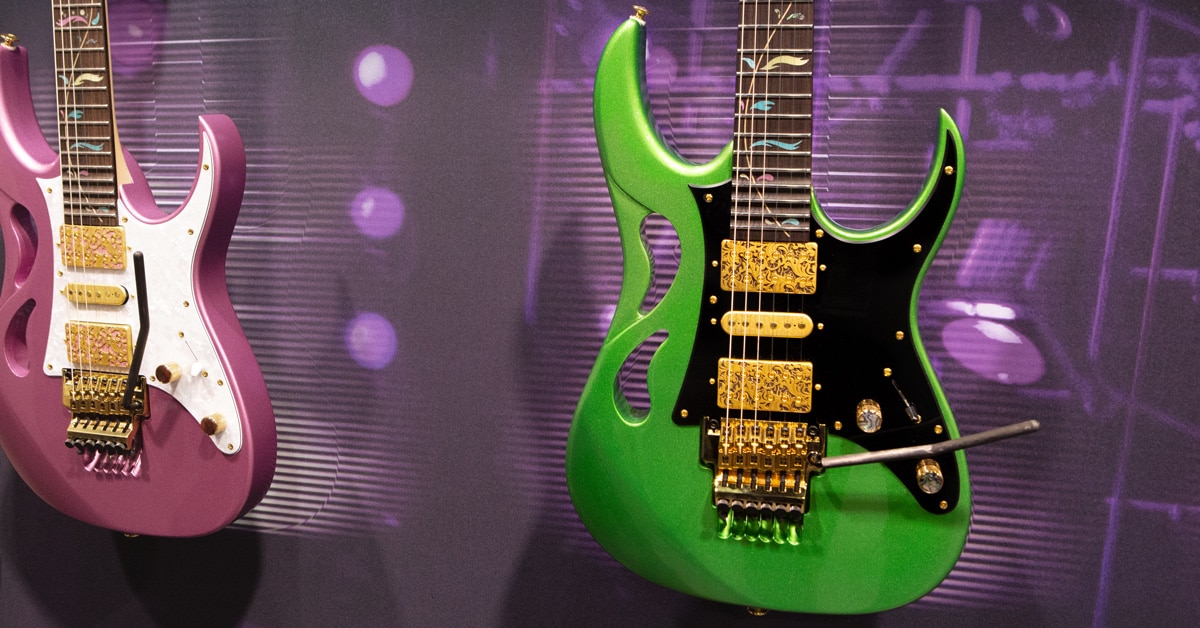When Steve Vai and Ibanez started working together to design Vai's signature JEM guitar in 1985, they probably had no idea that it would still be a current model over thirty years later. In many ways, the JEM became one of the most iconic instruments for technically adventurous guitarists. Like all artists, time brings change, and Vai felt it was time to revisit the design and create a freshly evolved guitar that reflects his growth as an artist and as a person. This new instrument is the result of a painstaking development process that blends the exhilaration of the original JEM with advances in design, function and aesthetics. The end result was dubbed "Paradise in Art," or "PIA" by Vai when it was deemed worthy of his exacting standards. Musician's Friend reached out to Ibanez with a few questions about the design process and heard back from Rocky Oda at Ibanez USA with some perspective on both the guitar and the development process.
The HUB: What led up to the decision to design a new signature guitar for Vai? Where and how did the idea originate?
Rocky Oda: While celebrating 30 years since the release of the Ibanez JEM, Steve approached the company at the 2017 NAMM show about the idea of creating the next evolution of the JEM. Steve had always envisioned that the JEM would evolve since it's conception in '80s, and after 30 incredible years of the JEM, he now felt that it was the perfect time to do something new. From that point on, both Steve and Ibanez began to design what would end up becoming the Ibanez PIA.
The HUB: What are some of PIA's most notable features? How do they differ from the JEM, and what was the reasoning behind the change?
RO: The new Petal Grip is definitely the PIA's most striking visual feature. It Is pretty obvious how It differs from the JEM, featuring 2 completely separated guitar body cutouts as opposed to the JEM's one 'Monkey Grip'. The cutouts are perfectly juxtaposed, and are reminiscent of the yin-yang sign. They also reminded Steve of a flower's petal, hence the name 'Petal grip'. Steve felt that the new "Petal Grip" contains an element of refinement and romance to the PIA. The new DiMarzio UtoPIA pickups are also an incredibly eye-catching and unique feature. Not only do they fit the aesthetic of the guitar, but also have been voiced to match the guitar's design and the needs of Steve perfectly after a rigorous sonic testing session conducted by Steve himself. Other notable features are the magnet fastened rear tremolo cavity plate, jeweled control knobs, and push/pull high-pass tone filter.

The HUB: What was the design process like with Vai? How hands-on was he, and how did the collaborative process work?
RO: Steve is always very involved with any project that we collaborate together on, and that was especially true for the PIA project. Steve had a hand in all of the design aspects of this new model, from personally tweaking the shape and size of the Petal Grip and PIA Blossom inlay pattern designs, deciding on the tonal output of the pickups, to selecting and naming each finish color, to name only a few examples. Steve would often inspire Ibanez with ideas or directions, and Ibanez would then develop designs based on what Steve conveyed. Steve would then fine tune the elements until they were completely satisfactory to him. It was a developmental process that was both exciting and inspirational for both Ibanez and Steve.
The HUB: What lessons were learned from the JEM that affected the design of the PIA?
RO: With Steve's 30+ year history of playing the Ibanez JEM, and Ibanez's 30+ year history of making them, it was easy to decide what could or should be changed when designing the PIA. The JEM was and still is an amazing guitar, so much of its DNA was carried over in the PIA. The PIA celebrates what makes a JEM so special all while adding a new twist on what has truly become a classic design.
The HUB: What was the inspiration for the "Petal Grip?" What was that development process like?
RO: The "Petal Grip" was chosen by Steve in its primitive form from a lineup of many different ideas that Ibanez had presented to him after discussing design directions with him. Steve then worked on refining the design with the designers at Ibanez, personally tweaking the design himself until it was completely satisfactory. Every angle, dimension and alignment were taken into consideration, and it took a few body samples before Steve felt that it was finally nailed.
The HUB: The JEM has been a successful design for more three decades. What do you think it is about Vai's signature models that resonates so widely?
RO: I believe that the appeal of Steve's signature models lies mainly in the beauty of their designs. From the JEM to the Universe and now the PIA, Steve's collaborations with Ibanez have not only satiated Steve's personal needs as an artist, but also answered the call of many other guitarists by providing them something that is original in both design and function. Steve's unwavering drive to push boundaries in all of his creative endeavors has led to the design of some of the most remarkable musical instruments the world has ever seen, and Ibanez is very immensely proud to be a part of that history.







































































































































